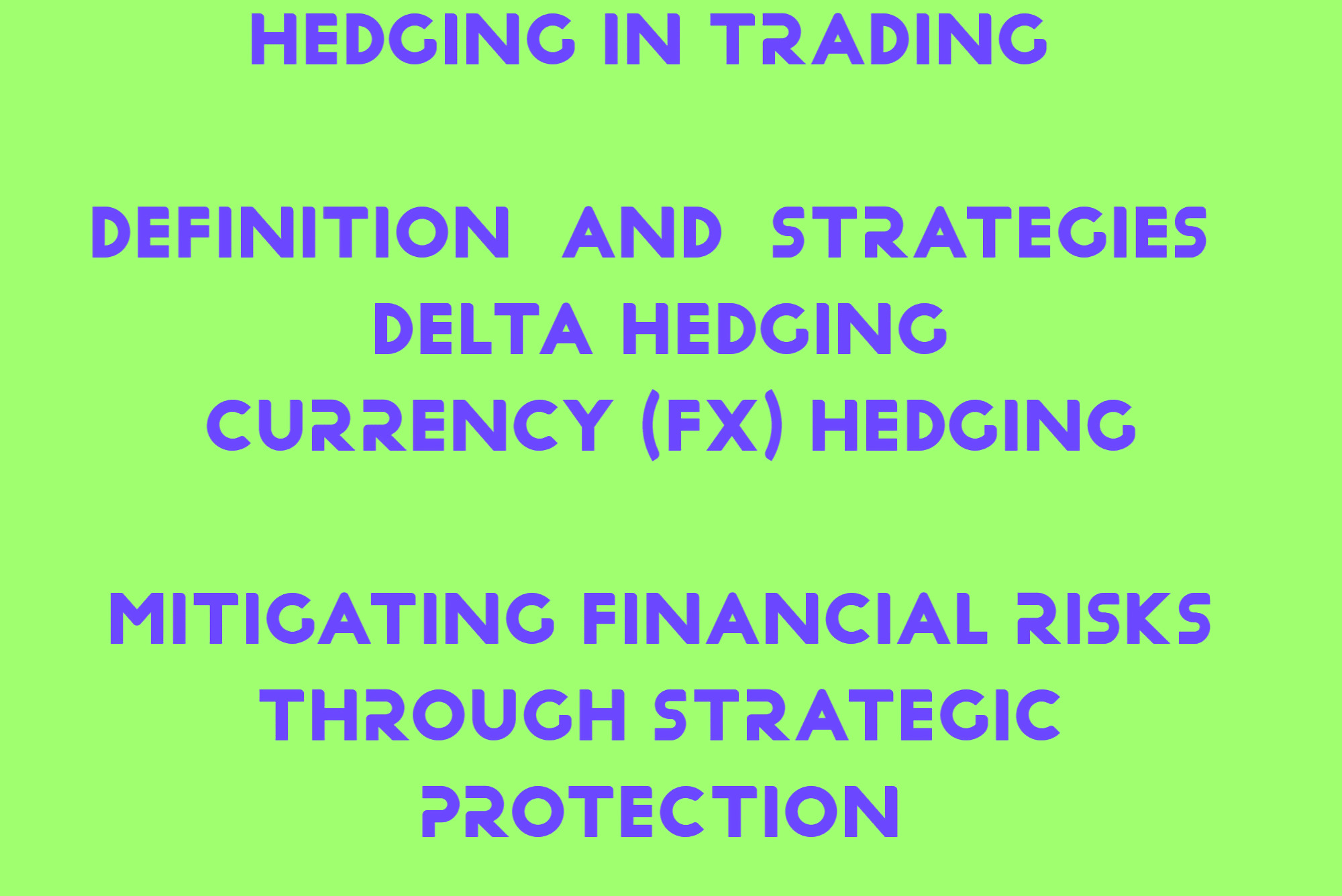What is Hedging in Trading?
Hedging is the execution of transactions for the purpose of insuring and protecting assets against financial risks.
The purpose of hedging operations is to minimize or compensate for the potential loss of asset value due to unfavorable market conditions. Hedging allows you to establish a known value for potential losses in the event of a decline in asset value. There are various hedging strategies.
The most popular ones involve the use of derivatives – futures and options. By purchasing a real asset and a put option on the same asset at the current price, an investor protects their investment from a decrease in asset value by limiting losses to the paid premium. Real commodity providers have utilized combinations of futures contracts and options on similar commodities to safeguard against price risks.
Diversification is a hedging strategy based on the formation of an investment portfolio. This strategy involves spreading an investor’s investments across different assets, often using combinations of shares from different sectors or shares and bonds in specific ratios. The essence of this strategy lies in the fact that when the price of one component in the portfolio falls, the prices of others may rise, offsetting the losses.
Hedging Meaning in Finance
Hedging is a financial strategy aimed at mitigating potential risks and protecting assets against adverse market conditions. It involves the execution of transactions that act as insurance policies, helping to minimize or offset potential losses in asset value. By employing hedging techniques, investors and businesses can limit their exposure to volatile market fluctuations and maintain a certain level of financial stability.
One of the most commonly used methods of hedging is through the use of derivatives, such as futures and options. Derivatives are financial instruments whose values are derived from an underlying asset. They offer investors the ability to hedge against potential losses by establishing contracts that provide protection in the event of adverse price movements.
For instance, an investor who purchases a real asset and simultaneously acquires a put option on the same asset at its current price can safeguard their investment from a decline in the asset’s value. If the asset’s price does indeed decrease, the investor’s losses are limited to the premium paid for the put option. This strategy allows investors to establish a predetermined level of risk and protect themselves from unfavorable market conditions.
In the realm of commodities trading, real commodity providers often employ combinations of futures contracts and options to hedge against price risks. By utilizing these derivative instruments, commodity producers can protect themselves from potential fluctuations in the price of the underlying commodity. This allows them to establish a level of price certainty and safeguard their profitability.
Another popular hedging strategy is diversification, which involves creating an investment portfolio that spans across different assets. The essence of diversification lies in spreading investments across various sectors, asset classes, or a combination of stocks and bonds in a certain proportion. By diversifying their portfolio, investors aim to reduce their exposure to any one particular investment and minimize potential losses.
The concept behind diversification is that when the price of one component in the portfolio falls, the prices of other assets may rise, helping to offset the losses. For example, if an investor holds shares of different companies across various sectors, a decline in the value of one stock may be counterbalanced by gains in other stocks within the portfolio. Diversification allows investors to reduce their overall risk and protect against the volatility of individual assets.
It is important to note that hedging strategies can vary depending on the specific objectives, risk tolerance, and investment horizon of individual investors or businesses. While derivatives and diversification are two commonly employed methods, there are numerous other hedging techniques available, including options strategies, forward contracts, and exchange-traded funds (ETFs), among others.
In conclusion, hedging plays a crucial role in managing financial risks and protecting assets against adverse market conditions. Whether through the use of derivatives or diversification strategies, investors can effectively mitigate potential losses and maintain a certain level of financial stability. By employing these hedging techniques, individuals and businesses can navigate uncertain market environments with greater confidence and safeguard their investments.
Hedging Definition
Hedging Strategies
Mitigating Financial Risks through Strategic Protection
In the ever-changing landscape of financial markets, investors and businesses face a myriad of risks that can impact the value of their assets. In such a volatile environment, the concept of hedging has emerged as a strategic tool to protect against potential losses and provide a level of insurance. Hedging involves the execution of transactions aimed at minimizing or compensating for the probable loss of asset value resulting from unfavorable market conditions. It offers individuals and organizations the ability to navigate uncertain terrain with greater confidence and financial stability.
The primary purpose of hedging operations is to safeguard against potential losses and limit exposure to adverse market movements. By employing hedging strategies, investors can fix the amount of potential loss to a known value, thereby reducing uncertainty and preserving capital. There are various hedging strategies available, each designed to address specific risks and cater to different investment objectives.
One of the most widely utilized approaches to hedging involves the use of derivatives, particularly futures and options. Derivatives are financial instruments whose values are derived from an underlying asset. These instruments provide investors with the ability to hedge against potential losses by establishing contracts that offer protection in the event of adverse price movements.
Consider an investor who purchases a real asset and simultaneously acquires a put option on the same asset at its current price. In doing so, they create a safeguard against a potential decline in the asset’s value. If the asset’s price indeed decreases, the investor’s losses are limited to the premium paid for the put option. This hedging strategy allows investors to establish a predetermined level of risk and protect themselves from unfavorable market conditions.
Real commodity providers also frequently utilize combinations of futures contracts and options to hedge against price risks. By employing these derivative instruments, commodity producers can protect themselves from potential fluctuations in the price of the underlying commodity. This enables them to establish a level of price certainty, ensuring the stability of their operations and safeguarding their profitability.
Another popular hedging strategy is diversification, which involves the creation of an investment portfolio comprising various assets. Diversification seeks to spread investments across different sectors, asset classes, or a combination of stocks and bonds in specific proportions. The underlying principle of diversification is to reduce exposure to any one particular investment and mitigate potential losses.
Through diversification, when the price of one component in the portfolio falls, gains in other assets within the portfolio may offset the losses. For example, an investor holding shares of different companies across various sectors may experience a decline in the value of one stock. However, if other stocks within the portfolio rise in value, it helps compensate for the losses incurred. Diversification acts as a risk management tool, allowing investors to minimize the impact of individual asset volatility and protect against concentrated risks.
It is important to note that hedging strategies can vary based on individual objectives, risk tolerance, and investment horizon. While derivatives and diversification are two commonly employed methods, there is a wide array of other hedging techniques available. These include options strategies, forward contracts, exchange-traded funds (ETFs), and more, each with its own advantages and considerations.
In conclusion, hedging plays a vital role in managing financial risks and protecting assets in a dynamic and unpredictable market environment. Whether through the use of derivatives or diversification strategies, investors can effectively mitigate potential losses and maintain a certain level of financial stability. By employing these hedging techniques, individuals and businesses can navigate turbulent market conditions with greater confidence and protect their investments from unforeseen circumstances. As the financial landscape continues to evolve, the importance of hedging as a strategic risk management tool remains steadfast.

Delta Hedging
Managing Risk through Dynamic Portfolio Adjustments
In the world of finance, managing risk is a crucial aspect of successful investing. One technique that has gained prominence is delta hedging, a strategy used to mitigate the exposure to price movements of derivatives in relation to their underlying assets. By employing delta hedging, investors can effectively manage risk and maintain a balanced portfolio in the face of market volatility. This article aims to provide a comprehensive understanding of delta hedging and its application in risk management.
Delta, often represented by the Greek letter Δ, is a measure of the sensitivity of an option’s price to changes in the price of its underlying asset. It indicates the degree to which the option’s price will move in response to a change in the underlying asset’s price. A delta of 1 signifies a one-to-one movement, where the option price will increase or decrease in tandem with the underlying asset’s price. A delta of 0.5 suggests that the option price will move half as much as the underlying asset price.
What Is Delta Hedging?
Delta hedging involves establishing a position in the underlying asset that offsets the delta exposure of the derivative. The primary objective is to construct a portfolio where changes in the option’s value are offset by corresponding changes in the value of the underlying asset, resulting in a risk-neutral position.
To execute a delta hedge, an investor would take the following steps:
- Determine the delta of the option: The delta value of the option can be obtained from pricing models or trading platforms. It reflects the sensitivity of the option’s value to changes in the underlying asset’s price.
- Calculate the number of options to hedge: To neutralize the delta exposure, the investor needs to determine the number of options to hedge. This is done by dividing the delta of the option by the delta of the underlying asset. For example, if the option has a delta of 0.6 and the underlying asset has a delta of 1, the investor would need to hedge by buying or selling 0.6 underlying assets for each option contract.
- Adjust the portfolio: Once the number of options to hedge is calculated, the investor will make the necessary adjustments to their portfolio by buying or selling the underlying asset accordingly. This dynamic adjustment ensures that changes in the option’s value are offset by changes in the value of the underlying asset, effectively hedging the delta exposure.
Delta hedging is most commonly utilized in the context of options trading, where the objective is to neutralize the delta risk of the option position. By dynamically adjusting the portfolio based on changes in the delta, investors can maintain a risk-neutral position and reduce their exposure to price fluctuations in the underlying asset.
The effectiveness of delta hedging depends on several factors, including the accuracy of the delta estimation, transaction costs, liquidity of the underlying asset, and the time sensitivity of the options. It is important to note that delta hedging is not a foolproof strategy and may not eliminate all risks. However, it can significantly reduce the impact of price movements and provide a measure of stability in a portfolio.
Delta hedging is particularly relevant in markets with high volatility or when dealing with complex derivatives. It allows investors to manage their risk exposure dynamically, adapting to changing market conditions and ensuring their portfolio remains aligned with their risk tolerance and investment objectives.
In conclusion, delta hedging is a powerful risk management technique that helps investors navigate the uncertainties of derivative markets. By offsetting the delta exposure of options through dynamic adjustments to the underlying asset, investors can achieve a risk-neutral position and minimize the impact of price movements. While delta hedging requires careful monitoring and adjustment, it offers an effective means of managing risk and maintaining a balanced portfolio. As investors continue to seek strategies to protect their investments, delta hedging remains a valuable tool in their arsenal.
Basic Delta Hedging Example
| Position | Delta | Directional Bias | Expected Profit/Loss per $1 Change in Stock Price |
|---|---|---|---|
| B | -3,000 | Bearish | -$3,000 |
| After Hedging | -1,500 | Less Bearish | -$1,500 |
Explanation: The table summarizes the information related to the position and the impact of hedging on the directional exposure.
- Position B initially has a delta of -3,000, indicating a bearish bias. It means that the position is expected to profit by $3,000 when the stock price drops by $1 and is anticipated to lose $3,000 when the stock price increases by $1.
- To reduce the directional exposure of the position, the trader decides to add positive delta strategies. They choose to buy shares of stock as a hedge.
- In order to decrease the directional risk by 50%, the trader calculates that they need to buy 1,500 shares of stock. Each share of stock has a delta of +1, which means buying 1,500 shares will add 1,500 deltas to the position.
- As a result, the new position delta becomes -1,500, reducing the bearish bias. With this adjusted delta, the trader is expected to lose $1,500 if the stock price increases by $1. This represents a 50% reduction in the expected loss compared to the initial -$3,000 loss per $1 increase in stock price.
The table helps visualize the impact of hedging on the position’s directional exposure and expected profit/loss per $1 change in the stock price.
Currency and FX Hedging
Protecting Against Foreign Exchange Risk
In an increasingly globalized world, businesses, investors, and individuals are exposed to the inherent risks associated with foreign exchange (FX) fluctuations. Currency values are influenced by a multitude of factors, including economic indicators, geopolitical events, and market sentiment. As a result, the need for effective currency and FX hedging strategies has become paramount. This article aims to provide a comprehensive understanding of currency and FX hedging, their significance, and the various strategies employed to manage FX risk.
Currency hedging is a proactive approach employed by individuals and organizations to protect against potential losses arising from adverse movements in exchange rates. The goal is to mitigate uncertainty and maintain stability in cash flows and financial projections. Currency hedging strategies are particularly crucial for businesses engaged in international trade, multinational corporations, and investors with foreign investments. By hedging currency exposure, these entities can safeguard their profits, costs, and investments from the volatility of FX markets.
One of the most common methods of currency hedging is the use of forward contracts. Forward contracts are agreements between two parties to exchange a specific amount of currency at a predetermined future date and exchange rate. By locking in the exchange rate, businesses can eliminate the risk of unfavorable currency movements. This provides certainty in cash flows, protects profit margins, and facilitates accurate budgeting and financial planning.
Currency options are another popular tool in currency hedging. Currency options give the holder the right, but not the obligation, to buy or sell a specific amount of currency at a predetermined price within a specified timeframe. These options provide flexibility and allow businesses and investors to limit downside risk while potentially benefiting from favorable currency movements. Currency options can be used to hedge both anticipated and unanticipated currency fluctuations, providing an effective means of risk management.
In addition to forward contracts and options, currency swaps are widely utilized in FX hedging strategies. Currency swaps involve the exchange of principal and interest payments in different currencies between two parties. These agreements allow counterparties to manage their cash flows, hedge against currency risk, and optimize financing costs. Currency swaps are commonly used by multinational corporations, financial institutions, and investors engaged in cross-border transactions.
Futures contracts are also employed in FX hedging. These standardized agreements to buy or sell a specified amount of currency at a predetermined future date and price are traded on organized exchanges. Futures contracts provide transparency, liquidity, and standardized terms, making them attractive to currency traders and investors seeking to hedge their positions and manage currency risk within their portfolios.
Structured products offer a customized approach to FX hedging by combining various derivative instruments. These products are tailored to meet the specific risk profiles and objectives of businesses and investors. Structured products may incorporate options, forwards, swaps, and other derivatives to provide comprehensive FX risk management solutions. They offer flexibility in designing hedging strategies and can be structured to mitigate specific risks while optimizing potential returns.
It is essential to understand that currency and FX hedging strategies do not eliminate currency risk entirely. Hedging involves costs, such as transaction fees and potential opportunity costs. Additionally, predicting currency movements accurately is challenging, and hedging decisions should be based on thorough analysis, risk assessment, and consideration of the desired financial outcomes.
In conclusion, currency and FX hedging strategies play a vital role in managing the risks associated with foreign exchange fluctuations. Through the use of forward contracts, currency options, currency swaps, futures contracts, and structured products, businesses, investors, and individuals can effectively protect themselves against adverse currency movements. By implementing appropriate hedging strategies, they can navigate the complexities of international trade, investment, and financial planning with greater confidence and stability.

-
“Unlocking the Power of Hedging: Strategies and Techniques for Financial Protection”
-
“Hedging 101: A Comprehensive Guide to Mitigating Financial Risks”
-
“Exploring the Benefits of Hedging: Safeguarding Your Investments in Uncertain Times”
-
“Mastering Hedging Strategies: A Deep Dive into Derivatives, Diversification, and More”
-
“Hedging Demystified: Understanding the Art of Balancing Risk and Reward”
-
“Building a Solid Financial Fortress: How Hedging Can Safeguard Your Wealth”
-
“The Role of Hedging in Investment Portfolios: Enhancing Stability and Performance”
-
“Hedging Techniques Unveiled: Insights into Options, Futures, and Beyond”
-
“Achieving Financial Resilience through Effective Hedging Strategies”
-
“Navigating Market Volatility: Harnessing the Power of Hedging for Long-Term Success”


